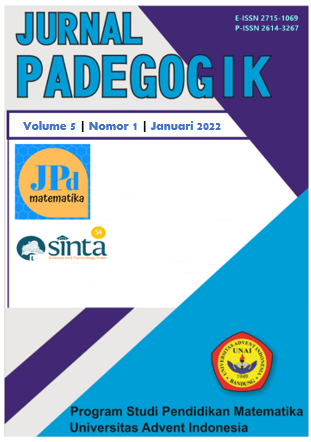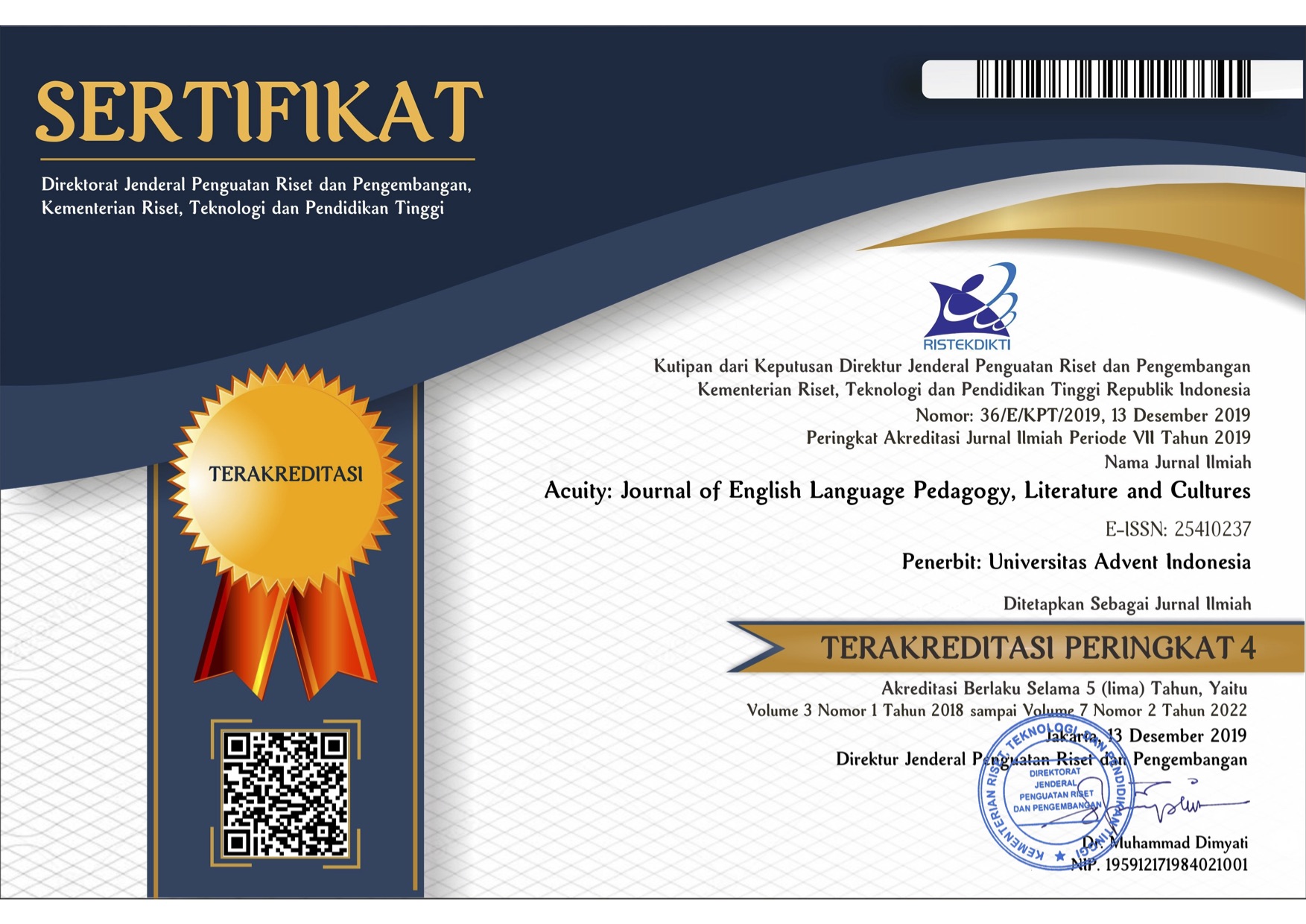ANALYSIS OF JUNIOR HIGH SCHOOL STUDENTS’ LEARNING OBSTACLES IN UNDERSTANDING THE CONCEPT ABOUT LINES AND ANGLES
Keywords:
Mathematical Concept Understanding Skills, Learning Obstacles, Lines and AnglesAbstract
Lines and angles as one of the math topic which is beneficial in life is attainable at junior high school. The results of the given learning can be observed by their understanding skills. In gaining mastery of understanding concepts of lines and angles, everyone will face obstacles. The purpose of this research is to analyze students’ understanding skills and learning obstacles which is experienced by students on the topic of lines and angles. Learning obstacles included are ontogeny obstacles, didactical obstacles, and epistemological obstacles. In this research, with SMP Advent Ciracas as the research places with a total subject of 26 students,it is found that:(1)42.3% of students are capable of restating concepts, (2)0% of students are capable of giving examples of a concept completely, (3)46.2% of students are capable of representing concepts, (4)23.1% of students are capable clasifying objects based on math concepts, and (5)3.8% of students are capable of connecting math concepts internally or externally. The average score is 4.69, with the maximum score obtainable is 10. This shows that the understanding skills of students is considered weak. For that, analysis on learning obstacles which is the causative factor is done. By the result of research, learning obstacles are found. Epistemological obstacles found are: (1)students have difficulty in identifying point on a line; (2)students mistakes the concept of parallel lines and have limited concept of line segments; (3)students have difficulty on perpendicular position of two lines; (4)students have difficulty computing complementary angles. Didactical obstacles found are: (1)the given learning which doesn’t serve students in constructing their knowledge; (2)weak reinforcement on prerequisite subjects for lines and angles; (3)obstacles caused by inadequate facilities. Ontogeny obstacles found are: (1)students’ unpreparedness in studying online; (2)lack of mental strenghts for studying lines and angles.
Downloads
References
Agustina, A., & Fuadiah, N. F. (2018). Kemampuan Pemahaman Konsep Matematika Siswa Kelas Vii Dalam Penerapan Model Penemuan Terbimbing. Jurnal LEMMA, 5(1), 52–60. https://doi.org/10.22202/jl.2018.v5i1.3006
Asih, K. S. (Universitas N. S., Rosita, C. D. (Universitas S. G. J., & Jati), T. (Universitas S. G. (2018). Analisis Learning Obstacles Pada Pokok Bahasan Aplikasi Turunan Pada Siswa Kelas XI SMA. Prosiding SNMPM II, II, 211–221. https://doi.org/10.24815/jdm.v7i1.15234
Brousseau, G. (2002). Theory of Didactical Situations in Mathematics. In Theory of Didactical Situations in Mathematics. https://doi.org/10.1007/0-306-47211-2
Dahlan, J. A., & Rohayati, A. (2012). Implementasi Strategi Pembelajaran Konflik Kognitif Dalam Upaya Meningkatkan High Order Mathematical Thinking Siswa. Pendidikan, 13(2), 65–76.
Dinni, H. N. (2018). HOTS ( High Order Thinking Skills ) dan Kaitannya dengan Kemampuan Literasi Matematika. Prisma, 1, 170–176.
Fauzia, T. A., Juandi, D., & Purniati, T. (2017). Desain didaktis konsep barisan dan deret aritmetika pada pembelajaran matematika sekolah menengah atas. Journal of Mathematics Education Research, 1(1), 1–10.
Gazali, R. Y. (2016). Pembelajaran Matematika Yang Bermakna. Math Didactic, 2(3), 181–190. https://doi.org/10.33654/math.v2i3.47
Kilpatrick, J., Swafford, J., & Findell, B. (2002). Helping Children Learn Mathematics. In Helping Children Learn Mathematics. https://doi.org/10.17226/10434
Lestari, K. E., & Yudhanegara, M. R. (2015). Penelitian Pendidikan Matematika (Anna (ed.)). PT Refika Aditama.
Mawaddah, S., & Maryanti, R. (2016). Kemampuan Pemahaman Konsep Matematis Siswa SMP dalam Pembelajaran Menggunakan Model Penemuan Terbimbing (Discovery Learning). EDU-MAT: Jurnal Pendidikan Matematika, 4(1), 76–85. https://doi.org/10.20527/edumat.v4i1.2292
Ramadhani, A., & Prahmana, R. C. I. (2019). Desain Pembelajaran Garis dan Sudut Menggunakan Jam Dinding Lingkaran untuk Siswa SMP Kelas VII. Jurnal Review Pembelajaran Matematika, 4(2), 85–101. https://doi.org/10.15642/jrpm.2019.4.2.85-101
Sulthoniyah, A. (2017). Analisis kemampuan berpikir kritis dalam menyelesaikan soal cerita pada materi aritmetika sosial. 769–778.
Supriyadi, E., Sabandar, J., & Yogaswara, M. (2017). PENINGKATAN KEMAMPUAN PEMAHAMAN MATEMATIS MENGGUNAKAN DESAIN DIDAKTIS BERDASARKAN KESULITAN BELAJAR PADA MATERI SISTEM PERSAMAAN LINEAR DUA VARIABEL. Jurnal Pendidikan Matematika

Downloads
Published
How to Cite
Issue
Section
License
Copyright (c) 2022 Jurnal Padegogik

This work is licensed under a Creative Commons Attribution-NonCommercial-ShareAlike 4.0 International License.
The submitting author warrants that
- The submission is original and that she/he is the author of the submission together with the named co-authors; to the extend the submission incorporates text passages, figures, data, or other material from the work of others, the submitting author has obtained any necessary permission.
- Articles in this journal are published under the Creative Commons Share-Alike Attribution Licence (CC-BY-SA What does this mean?). This is to get more legal certainty about what readers can do with published articles, and thus a wider dissemination and archiving, which in turn makes publishing with this journal more valuable for you, the authors.
- By submitting an article the author grants to this journal the non-exclusive right to publish it. The author retains the copyright and the publishing rights for his article without any restrictions.







